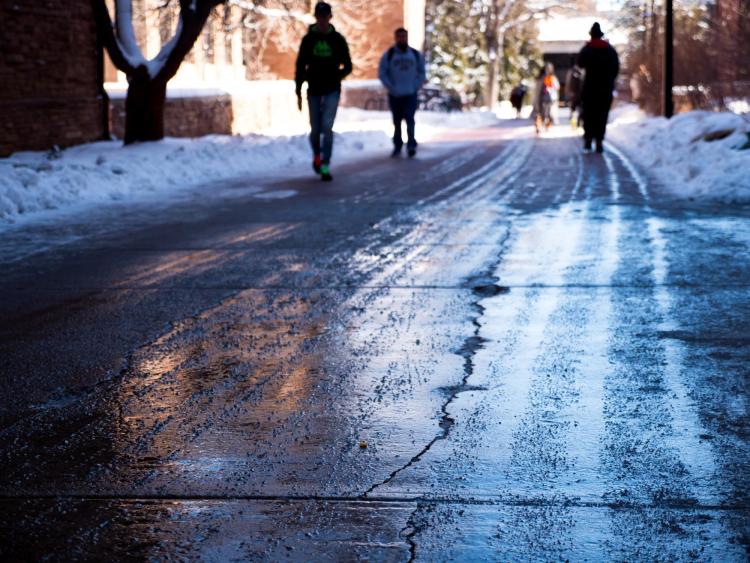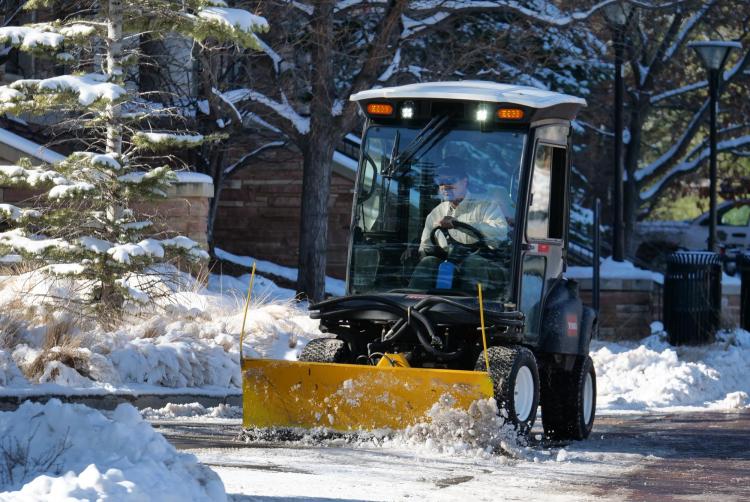Campus snow removal an exercise in safety, coordination
Eight snow seasons in as assistant director of outdoor services at CU Boulder, Don Inglis still cringes each time he sees it: A pedestrian who notices Inglis’s Jeep Wrangler snow plow coming up a sidewalk and runs to get out of the way.
Inglis appreciates the gesture. He just wants students and campus employees to know he and his crews are more concerned with your safety than blowing past without hitting the brakes.

Photo by Patrick Campbell / University of Colorado Boulder
“I hate seeing that because I am so worried they’re going to go down,” Inglis said during a January 2017 blizzard over the holiday break that dumped more than a foot of snow on campus. “Our guys understand that pedestrians—that’s why we’re here. We’re making things safe for them. We’re not pushing them out of the way. We will wait for you, so don’t feel that you need to run to get out of our way.”
Keeping an eye out for some 30,000 pedestrians that may be roaming campus at any one time might top the list of importance, but it’s one of many intricacies that goes into campus snow cleanup.
Snow removal at CU Boulder is an all-hands-on-deck choreographed operation that involves Facilities Management, Parking and Transportation Services, Housing and Dining Services, Custodial Building Services, Athletics and the city of Boulder. And it’s one that often sees dedicated employees of those various departments showing up at 4 a.m.—or in some cases spending the night—to ensure campus is safe and can remain open when flakes fly.
“A dance that goes on”
Inglis’s crew in Facilities Management (FM) is responsible for grounds upkeep around all general-fund buildings and areas of campus. When it comes to snow removal, the FM arsenal that tackles Main Campus includes a trio of three-quarter-ton pickups that hit streets and larger sidewalks with both plows and materials spreaders, three Jeep Wranglers, three Kubota utility vehicles with plows and spreaders, and two Bobcat skid loaders. That’s in addition to FM custodial and grounds workers, and even some tradesmen, who are pulled away from their normal duties to pitch in with shoveling areas like stairs and building entrances.
And that’s to say nothing of a whole separate FM crew that keeps East Campus clean; or Housing, which has its own facilities crews, making sure areas around the residence halls and dining centers are clear; or Parking and Transportation, which manages the clearance of most parking lots on campus, including somewhere north of 7,000 parking spaces. And don’t forget Athletics, or that the city is responsible for Regent Drive, as well as Colorado Avenue all the way from 28th Street to Folsom Street.
- The CU Boulder emergency closure policy
- Colorado Department of Transportation winter driving safety tips, reminders and road conditions
- Snow removal in the city of Boulder
- National Weather Service: Boulder forecast
All coordinate via a campus snow committee that meets monthly to create route maps and strategies that ensure the right equipment is matched to the right routes, that all parts of campus are covered, and that, say, one department isn’t dumping snow in an area that another department is trying to clear.
“There is kind of a dance that goes on,” said Inglis, who for the January storm spent the night on a cot in his office at the Grounds and Recycling Operations Center, affectionately referred to by workers there as the G-ROC. “There’s plenty of snow for everybody to push.”
While Facilities and Housing run their own snow removal, Parking and Transportation Services (PTS) contracts with Boulder-based Keeter Trucking to clear its lots. Shauna Atkins, assistant director of infrastructure and capital projects for PTS, oversees that operation, arriving on campus at 2 a.m. for big storms.
One of the big challenges PTS and the other departments face is removing the snow piles once it’s plowed. Windrows plowed to the center of Colorado Avenue, for example, must eventually be hauled away, often to Buff Plaza or space on East Campus. While parking lots might seem like the perfect spot to pile snow and let it sit, Atkins doesn’t have that luxury. Buried parking spots mean the potential for unhappy permit holders and lost revenue.
“Anymore, it’s so tight on campus we just can’t do that,” Atkins said. “People are paying for parking and they feel they require a certain level [of service]. We try to give it to them. Our job is to scrape the lots from side to side.”
Addressing challenges
Snow removal during the holiday break when activity is light on campus presents plenty of challenges and obstacles to work around. But when classes are in session, pedestrian and vehicular traffic is exponentially higher. Contract maintenance workers from off campus who park trucks near buildings can prevent snow-removal crews from hitting certain spots. People who park on campus overnight, meanwhile, can leave the appearance of gaps in lot clearance.

Photo by Casey A. Cass / University of Colorado Boulder
For big storms, in particular, snow removal is a constant work in progress. After streets and main pedestrian arterials are broken open initially, detail work and haul-off can last for two or three more days. And snow-removal staff often spend extra hours on campus doing the best they can to make campus safe for all users.
“I think we go above and beyond any other municipality,” said Zac Cameron, FM’s turf-grass manager, whose crew’s winter days would normally consist of things like addressing poor drainage spots around campus, top-dressing fields and performing offseason equipment maintenance. “We pretty much have this place cleared out edge to edge.”
Of course, clearing sidewalks edge to edge doesn’t mean surfaces will be dry the day of a storm. That’s why CU Boulder’s snow-removal team urges extra caution and awareness when traversing campus in icy or snowy conditions. There might still be slick spots—or a plow just around the corner.
Inglis said that even when he sees pedestrians, sometimes they don’t see or hear him. Technology has been known to lead a few pedestrians who are engrossed in their smartphones to walk into parked plows or have other similar near misses. If he sees one of those instances coming, he’ll often offer a “courtesy toot” of the horn. If you get one, just remember the plow driver might not be trying to clear a path so much as save your shins from a painful encounter.
“That’s why we have backup beepers on everything,” Inglis said. “It’s just one more bit of awareness for them.”


